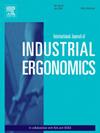Accessibility evaluation of assembly operations in confined space based on digital human model
IF 2.5
2区 工程技术
Q2 ENGINEERING, INDUSTRIAL
International Journal of Industrial Ergonomics
Pub Date : 2025-04-10
DOI:10.1016/j.ergon.2025.103719
引用次数: 0
Abstract
The confined spaces (CS) of large equipment are typically compact with intricate operational environments, which significantly affect the accessibility, efficiency, and operational quality of workers. Spatial accessibility evaluation, as a critical indicator of worker safety and product design optimization, is an essential part of equipment product design. This study proposes a comprehensive evaluation method based on digital human models (DHMs) and virtual reality systems (VRS) for the quantitative analysis of operational accessibility in CS. The method integrates DHMs and ergonomics data to analyze human dynamics, path accessibility, operational accessibility, and visibility. It defines the spatial restriction ratio (SRR) and the operational freedom ratio (OFR), and combines directional weight coefficients for specific operation types with REBA posture ratings to construct a multi-dimensional quantitative evaluation system. The experiment was based on 6 confined units and 11 operations of an equipment, recruiting 10 subjects to simulate real operations through VRS to validate the effectiveness of the method. The results of the tests demonstrate that the method can effectively evaluate the operation accessibility in CS, optimize the product layout, reduce the risk of musculoskeletal injuries for workers, and provide theoretical support for the iterative design of industrial equipment. It promotes the transition of operational accessibility evaluation in CS from experience-driven to data-driven precision upgrades, offering new perspectives and methodological support for the spatial layout optimization and scientifically reasonable operation planning of complex industrial products.
基于数字人模型的密闭空间装配作业可达性评价
大型设备的密闭空间(CS)通常紧凑且操作环境复杂,这极大地影响了工人的可达性、效率和操作质量。空间可达性评价是设备产品设计的重要组成部分,是工人安全和产品设计优化的重要指标。本研究提出了一种基于数字人体模型(DHMs)和虚拟现实系统(VRS)的综合评价方法,用于CS操作可达性的定量分析。该方法集成了dhm和人机工程学数据来分析人体动力学、路径可达性、操作可达性和可见性。定义了空间约束比(SRR)和作战自由度比(OFR),并将特定作战类型的方向权重系数与REBA姿态等级相结合,构建了多维度定量评价体系。实验以一台设备的6个受限单元和11种操作为基础,招募10名被试通过VRS模拟真实操作,验证方法的有效性。试验结果表明,该方法可有效评估CS操作可达性,优化产品布局,降低工人肌肉骨骼损伤风险,为工业设备的迭代设计提供理论支持。促进了CS运营可达性评价从经验驱动向数据驱动的精度升级转变,为复杂工业产品空间布局优化和科学合理的运营规划提供了新的视角和方法支持。
本文章由计算机程序翻译,如有差异,请以英文原文为准。
求助全文
约1分钟内获得全文
求助全文
来源期刊
CiteScore
6.40
自引率
12.90%
发文量
110
审稿时长
56 days
期刊介绍:
The journal publishes original contributions that add to our understanding of the role of humans in today systems and the interactions thereof with various system components. The journal typically covers the following areas: industrial and occupational ergonomics, design of systems, tools and equipment, human performance measurement and modeling, human productivity, humans in technologically complex systems, and safety. The focus of the articles includes basic theoretical advances, applications, case studies, new methodologies and procedures; and empirical studies.

 求助内容:
求助内容: 应助结果提醒方式:
应助结果提醒方式:


